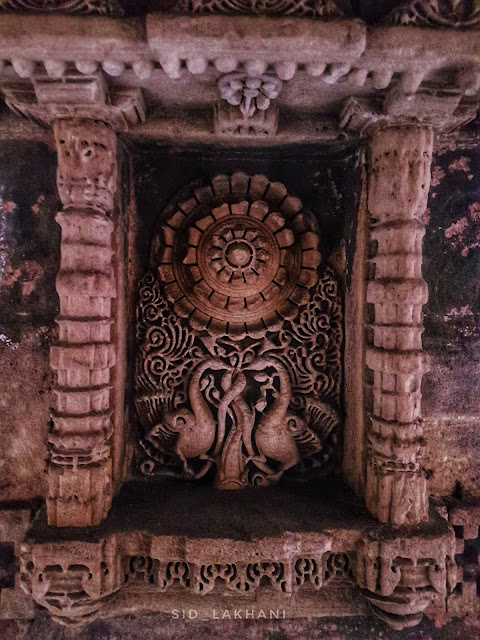Stepwells of Ahmedabad
Stepwells
Stepwells are wells or ponds in which water goes down and stored in a set of steps to the water level.
The purpose of making Stepwells was that the people can easily reach to the water level and can be easily maintained.
In Ahmedabad there are many Stepwells which are actually called as Vav in Gujarati.
Adalaj Ni Vav
 |
| Well in Adalaj Stepwell |
It is the most remarkable and well-known Stepwells of Ahmedabad. It is constructed as intricately carved and five stories deep.
According to history, its construction was started by Rana Veer Singh of the Vaghela dynasty, a Hindu ruler, but before this could be completed The Rana king was killed in battle.
Rana Veer Singh's widow, Rani Roopba (or Roodabai), wanted to perform Sati and join her husband in the afterlife. However, Begada prevented her from giving up her own life and proposed marriage. She agreed to a marriage proposal on the condition that he would first complete the building of the stepwell. Then he agreed to her condition and finished its construction.
After the construction completed, he reminded his proposal of marriage. Instead, Rani Roopba decided to end her life and jumped into the stepwell.
Due to Rani Rudabai it is also known as Rudabai Stepwell.
It is located in Adalaj Village near Ahmedabad City in Gandhinagar District.
 |
| Five Storied Structure of Vav from Bottom |
This is the view of five Storied structures of vav from the bottom, which looks so beautiful and stunning.
 |
| Design and Carving on one of the pillars of Vav |
This is the photo of carving on one of the pillars of the Vav which looks so complex but brilliant.
 |
| Jharukhon |
Jharukhon in stepwell is one of the prominent spots for photographers because of its attractive design and carving.
The timing to visit this place is 6:00 AM to 6:00 PM.
Dada Harir Ni Vav
 |
| Inscription in Sanskrit |
 |
| Inscription in Arabic |
There are two inscriptions in stepwell which describes the history of the stepwell.
One is in the Sanskrit language which is on the Southside of the wall and the other is in the Arabic Language which on the Northside of the wall.
 |
| View from top to bottom |
This is the view of the five-storied structure of Vav from Top to Bottom.
The structure of the Well is in Octagonal shape.
 |
| Design in Dada Harir ni Vav |
 |
| Mosque of Dada Harir |
Just behind the stepwell, there is a Mosque and Tomb of Dada Harir where she was buried.
Mata Bhavani ni Vav
 |
| Mata Bhavani ni Vav |
Just after 5 minutes of walk from Dada Harir Ni Vav there is Mata Bhavani's Stepwell or Mata Bhavani Ni Vav in Asarva Village.
It is not the most popular, but it is said to be one of the earliest Stepwells in Gujarat, which was built in the Chaulukya Dynasty during the 11th century.
It is the three storied Stepwell.
Inside the stepwell at the lower pavilion there is the temple of Mata Bhavani which derives its name.
It was built before the establishment of the oldest city Ahmedabad.
The timing to visit this place is 6:00 AM to 6:00 PM.
It is not the most popular, but it is said to be one of the earliest Stepwells in Gujarat, which was built in the Chaulukya Dynasty during the 11th century.
 |
| Temple of Mata Bhavani |
Inside the stepwell at the lower pavilion there is the temple of Mata Bhavani which derives its name.
It was built before the establishment of the oldest city Ahmedabad.
The timing to visit this place is 6:00 AM to 6:00 PM.
It is located in the Heart of the Walled City Ahmedabad. It is located beside Panchkhuva Darwaja near Kalupur Railway Station by which it is also called as Panchkuva Stepwell.
Panchkuva means five wells.
Amritavarshi Ni Vav was completed in 1723 as per Devanagari and Persian inscription (Vikram Samvat 1779/A.H. 1135) in the stepwell.
It was built by Raghunathdas, Diwan to Haidar Quli Khan, who was the governor of Gujarat during his stay in the city in 1721–1722 for charitable purposes.
It is also called as Katkhuni stepwell due to its L-Shaped plan and there is no ornamental designing or carving on the walls or pillars of stepwell yet, it is the simplest and stunning.








Comments
Post a Comment